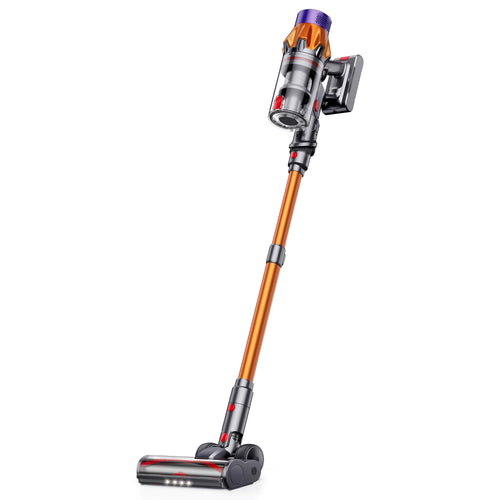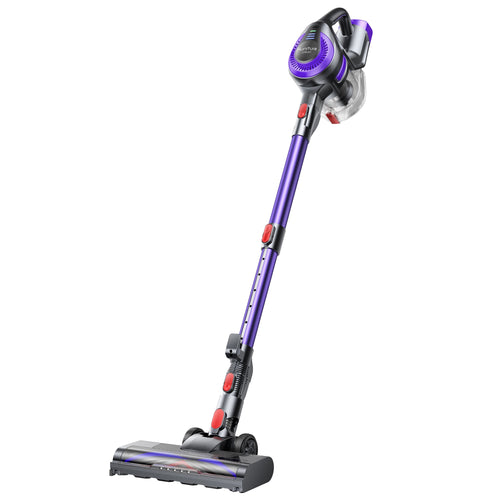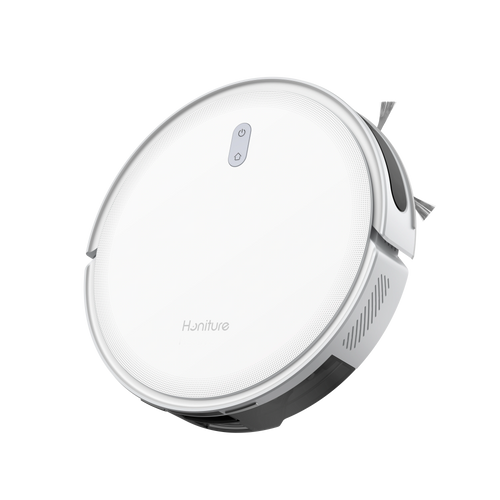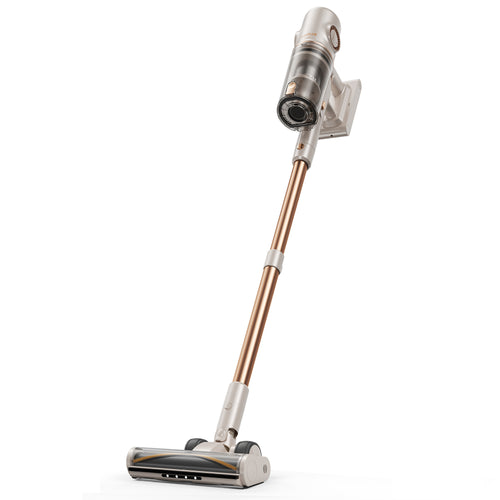What we commonly call "suction power" is actually a combination of several factors. The two main metrics are airflow and sealed suction.
Airflow (in cubic feet per minute or CFM): This measures the volume of air the vacuum can move. Higher CFM means the vacuum can move more air quickly, which is great for picking up light debris like dust and pet hair from carpets.
Sealed Suction (in inches of water lift): This measures the vacuum's ability to lift weight against gravity. Higher water lift indicates the vacuum's power to pull heavy debris and dislodge dirt that's embedded deep in carpets.
A powerful vacuum cleaner needs a good balance of both. For example, a vacuum might have high airflow but low sealed suction, making it good for surface cleaning but ineffective at deep cleaning. Conversely, a vacuum with high sealed suction but low airflow might be able to pull up heavy dirt but not move enough air to effectively clean a large area.
Many people focus solely on “the higher the power, the better” when buying a vacuum cleaner. However, motor power (measured in watts) does not equal suction power. The true measure of suction is called Air Watts (AW) or Pa/kPa— a unit that takes into account both airflow and vacuum pressure. In other words, real suction means it can pull and move debris effectively, not just have a big number on the spec sheet.
Common Misconception for The Suction Power of Vacuum Cleaner:
|
Common Misconception |
What You Should Know |
|
Judging suction by motor wattage |
Check Air Watts (AW) or Pa/kPa for actual suction |
|
Higher suction is always better |
Suitability matters more; too high can waste energy and damage floors |
|
Higher suction means louder noise |
This is not an absolute correlation. Noise can be reduced by motor type and soundproof design |
|
Always choose the highest setting |
Adjustable suction is more practical for different floors and needs |
How Is Vacuum Suction Power Measured?
One of the most common questions when buying a vacuum cleaner is: “How powerful is the suction?” You may be familiar with the following common suction-related metrics but unsure of the definitions behind the numbers — suction involves several technical measurements, and different brands may present them differently.
Common suction-related metrics include:
|
Metric Name |
Abbreviation |
Description |
Reflects Actual Suction? |
|
Power |
Watts (W) |
The electrical power consumption of the motor, not suction |
No |
|
Vacuum Pressure |
Pa / kPa |
The vacuum level created inside the device, higher means stronger suction |
Yes |
|
Airflow |
CFM |
Cubic Feet per Minute – volume of air moved by the vacuum |
Yes |
|
Air Watts |
AW |
Combines airflow and vacuum pressure to measure real suction power |
Yes, highly accurate |
Air Watts (AW) is currently one of the most accurate ways to measure real suction power. For example, a high-performance vacuum typically delivers 120–200 AW.
Understanding Suction Power Through Pa / kPa
When Air Watts (AW) aren’t provided, the vacuum pressure, measured in Pascals (Pa) or kilopascals (kPa), is a useful indicator of suction strength. This value reflects how much negative pressure (vacuum) the cleaner can create inside its suction path.
What is Pascal (Pa)?
It’s a unit of pressure measuring force per square meter. In vacuums, it tells you how strong the suction “pull” is.
Typical values:
Entry-level cordless vacuums: around 5–10 kPa (5000–10,000 Pa)
Mid-range models: 10–15 kPa
High-end models: 15+ kPa
What does a higher Pa/kPa mean?
The higher the value, the stronger the vacuum’s ability to lift dirt and debris from surfaces — especially useful for carpets and embedded pet hair.
Honiture’s most powerful cordless vacuum to date is a newly launched champagne gold model-Honiture P7 Pro cordless stick vacuum. Tested and approved by different users, its suction is especially effective for both carpet and hard floor cleaning.
How to Use Pa/kPa When Choosing a Vacuum?
Look for a vacuum with at least 10 kPa for reliable daily cleaning on hard floors and low-pile carpets.
For homes with thick carpets or pets, aim for models around 15 kPa or higher. Honiture’s cordless vacuums start at 30 kPa and go up to 50 kPa — high-performance tools designed for powerful, multi-surface cleaning.
If you see only watts and no Pa/kPa, remember watts reflect motor power but don’t guarantee suction strength.
Suction Power: Cordless Vacuum vs. Robot Vacuum
|
Feature |
Cordless Vacuum |
Robot Vacuum |
|
Typical Suction Power |
Higher, often 100–200+ Air Watts or 10–20+ kPa |
Lower, usually 15–50 Air Watts or 3–10 kPa |
|
Motor Size & Battery |
Larger motors, bigger batteries for more suction and longer runtime |
Smaller motors, compact batteries due to size constraints |
|
Cleaning Focus |
Deep cleaning, carpets, upholstery, stairs, corners |
Daily maintenance, hard floors, light carpets |
|
Suction Modes |
Multiple power levels, including max turbo mode |
Usually 1–3 modes, limited max suction |
|
Noise Level |
Can be louder due to stronger motors |
Generally quieter for home convenience |
Why the Difference?
1. Size & Weight Constraints: Robot vacuums must fit into a slim, low-profile body to navigate under furniture, limiting motor size and battery capacity. Cordless vacuums can be bigger and heavier with more powerful motors.
2. Use Case: Robots aim for frequent, automated light cleaning, while cordless vacuums are designed for deeper, spot or whole-home cleaning.
3. Battery Life & Runtime: High suction drains battery fast. Robots balance suction and runtime to clean entire rooms on one charge.
What Does This Mean for Users?
If you need deep cleaning, heavy carpet cleaning, or spot cleaning of stubborn dirt, cordless vacuums are better suited.
If you want hands-free daily maintenance on hard floors or light carpets, robot vacuums are ideal.
Many households benefit from using both: a robot vacuum for everyday upkeep plus a cordless vacuum for detailed cleaning sessions. If you are looking for both, explore more affordable vacuum cleaner at Honiture.
Is Higher Suction Always Noisier?
Increasing suction power usually means higher motor speed, stronger airflow, more noticeable structural vibration and airflow noise. However, this isn’t always the case, because:
1. Air channel design: Noise-reduction design can help minimize sound — such as multi-layer insulation and streamlined airflow channels.
2. Motor type: High-quality brushless motors tend to run more quietly than traditional brushed motors.
3. Body insulation and sealing: Some brands offer a dedicated “quiet mode”, which reduces noise by lowering suction power when full performance isn’t needed.
Many premium vacuums maintain strong suction while keeping noise around 68–72 dB. For example: At the same 200AW suction level, a standard vacuum might reach 78dB, while a high-end model can stay under 70dB thanks to better engineering.
Do You Really Need the Maximum Suction Power?
Not always. While higher suction means more cleaning power, it may also come with more weight, shorter battery life, and even be too rough on delicate surfaces.
Recommended suction levels (Air Watt-based):
|
Household Type |
Recommended Air Watts |
Approx. Suction Pressure (Pa) |
Notes |
|
Small apartments / daily use |
80–120 AW |
10,000–13,000 Pa (10–13 kPa) |
Ideal for dust, hair, and hard floors |
|
Homes with pets |
130–160 AW |
13,000–18,000 Pa (13–18 kPa) |
Stronger suction for pet hair and dander |
|
Allergy-prone or carpet-heavy households |
180+ AW |
18,000–25,000+ Pa (18–25+ kPa) |
Deep cleaning of carpets, allergens, and embedded dirt |
|
Spot/vehicle cleaning |
50–80 AW |
5,000–9,000 Pa (5–9 kPa) |
Lightweight, portable models are ideal |
The right suction is the one that suits your lifestyle — not just the biggest number.
Quick Tips for Choosing the Right Suction Power:
Don’t rely on wattage alone — check Air Watts or Pa rating.
Adjustable suction levels are better for mixed surfaces.
Balance suction power with battery life, weight, and noise.
Read user reviews to get the real picture.
More suction isn’t always better. The smartest cleaning solution balances power, noise, and comfort — made for real life, not just spec sheets.
































